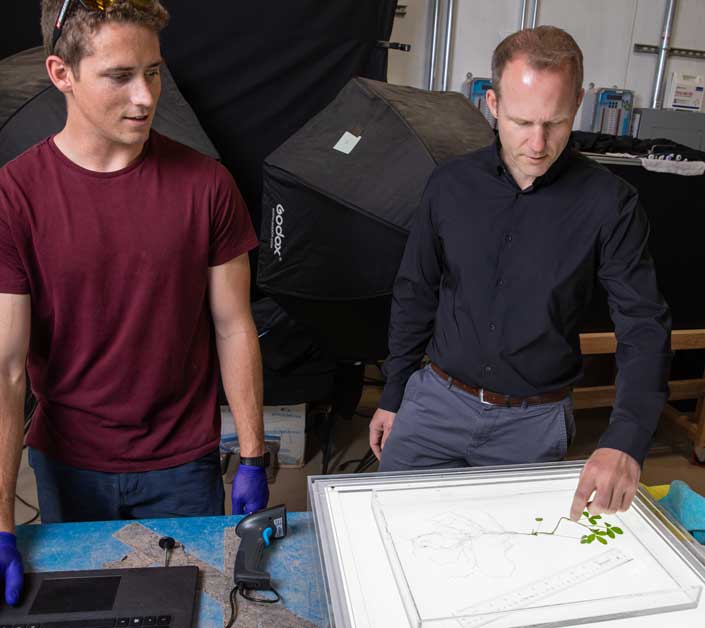Growing Our Way out of a Climate Crisis
Genetically enhanced crops could be the best way to meet CO2 removal at the scale it needs
Story by:
Media contact:
Published Date
Story by:
Media contact:
Share This:
Article Content
UC San Diego researchers say genetically-enhanced crops of plants featuring enlarged roots present an opportunity for society to achieve a needed drawdown of carbon dioxide from the atmosphere.
A new study from scientists at UC San Diego’s Scripps Institution of Oceanography and School of Global Policy and Strategy (GPS) also compares this agricultural solution to other proposed methods of carbon dioxide removal (CDR) as a way of showing what needs to happen to address the climate crisis on a global scale.
Scientists contributing to the most recent Intergovernmental Panel on Climate Change report have estimated that if society is to have a chance at counteracting global CO2 emissions, it must find a way to remove between five and 16 billion tons of the greenhouse gas every year. That would need to be done in addition to the task of stopping or substantially slowing how much greenhouse gas society continues to add to the atmosphere daily. Failure to do this in a timely manner puts the planet at risk of experiencing catastrophic changes in weather, crop failures and spread of diseases.
Despite the magnitude of the challenge, nobody has offered a theory to explain how quickly such technologies can scale under real world conditions, said study lead author Daniela Faggiani-Dias, a climate scientist at Scripps Oceanography and UC San Diego’s Deep Decarbonization Initiative. Following an analysis, so-called carbon-enhanced crops could, within 13 years of first adoption, remove 0.9–1.2 gigatons annually, the research team said. That amount is about seven times larger than all CO2 offsets supplied today to the global market.
“There is a consensus in the scientific community that we will have to scale CDR substantially to reach net zero - on top of drastically reducing our greenhouse gas emissions,” said Faggiani-Dias. “Yet, research on how CDR can realistically scale—considering not only technical limits, but also scale-up speed and feasible pathways—is very thin. And this is what is new about our study. We provide a detailed analysis of the CDR scaling challenge and propose a framework to estimate how quickly and to what extent emerging, highly uncertain technologies might scale. While our analysis focuses on carbon-enhanced crops, the framework is generalizable across CDR approaches and helps to surface key uncertainties in scale-up potential.”
The research team used examples throughout history to see how new technologies have proliferated in the past — how long they took to become commonplace and what barriers they had to overcome before doing so.The study compares those examples to the promising field of crop modification, which the authors note, has already managed to progress much faster than other innovations thanks to a well-established infrastructure of knowledge and marketing within the agriculture industry. Additionally, farming over recent centuries has depleted soils of carbon making the plowed earth a ready repository of new stores.
These advantages place genetic enhancement of crops far ahead of other proposed strategies for carbon removal, such as sequestration of carbon in rock deposits or filtering it out of the atmosphere or ocean.
The other strategies take time to mature, the authors said, because they rely on the creation of new industries from scratch. They also need years of testing to ensure that they will work as expected without risking unintended consequences.
Enhanced crops could more easily proliferate within a mature agriculture industry with a proven record of innovation and capacity to scale up new practices and technologies, though typically with yield as a focus rather than atmospheric CO2.
To understand how carbon-enhanced crop use can be scaled up, the researchers looked at other innovations from the past that improved yields, such as creation of hybrids, use of pesticides, improving fertilizers and crop rotation.
The innovation most like it was genetic modification, which profited farmers and then those industries supplying farmers with seed and other materials. The practice, however, has been controversial and not all countries allow the growing of genetically modified crops, especially food crops.
The research team used the history of genetic modification to get a sense of how long it could take for carbon-enhanced crops to become widespread given the regulatory barriers and public perception issues they could face. The scientists found that in countries that allow genetically modified crops, it took an average of 11 years to go from early adoption to widespread use.
They also noted, however, that given resistance to genetic modification, it has only spread to about 13 percent of all the agricultural land in the world. Carbon-enhanced crop usage could face a similar ceiling unless incentives such as carbon credits to countries that adopt the practice are provided.
If it did, the benefit of carbon-enhanced crops could be significant, but not enough on its own, the authors said. Faggiani-Dias reminds that all such efforts need to be just one component of a global effort to decarbonize the economy.
The work was funded by private philanthropy through Scripps Institution of Oceanography as well as the Electric Power Research Institute through the Deep Decarbonization Initiative at UC San Diego and the Peter Cowhey Center for global transformation at the school of Global Policy and Strategy at UC San Diego.
Study co-authors include David Victor and Ryan Hanna of the Deep Decarbonization Initiative at UC San Diego, Jeffrey Sachnik and Yangyang Xu of Texas A&M University, Wolfgang Busch of the Salk Institute in La Jolla, Calif., and Jack Gilbert of Scripps Oceanography.
Learn more about research and education at UC San Diego in: Climate Change

Share This:
Stay in the Know
Keep up with all the latest from UC San Diego. Subscribe to the newsletter today.




